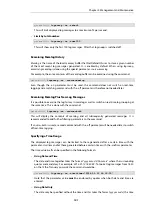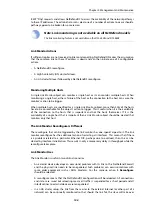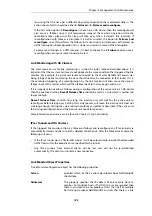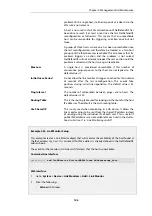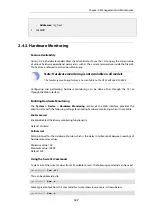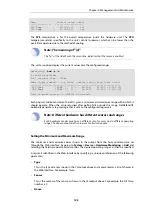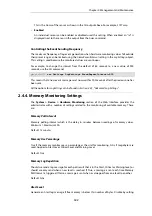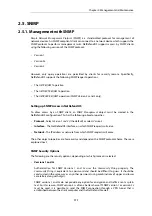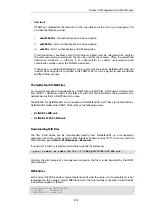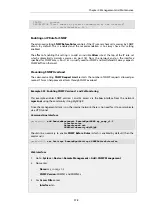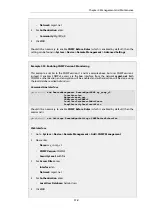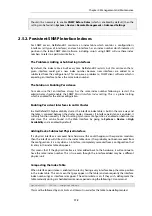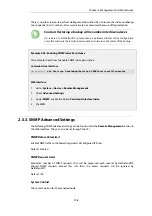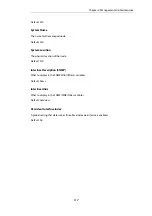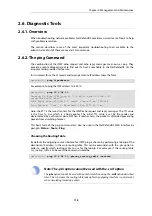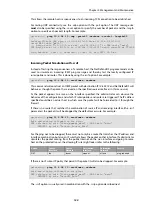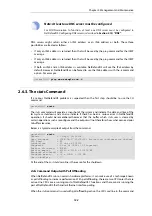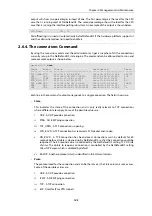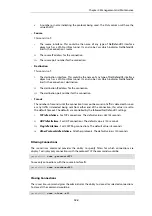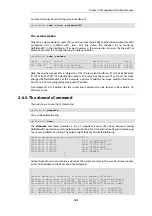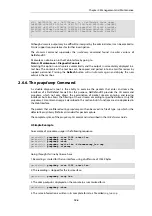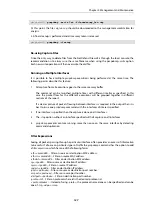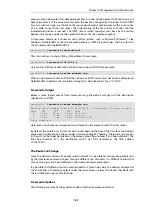
Should it be necessary to enable SNMP Before Rules (which is enabled by default) then the
setting can be found in System > Device > Remote Management > Advanced Settings.
2.5.2. Persistent SNMP Interface Indexes
For SNMP access, NetDefendOS maintains an index table which contains a configuration's
interfaces (all types of interfaces) and each interface has an index number which indicates its
position in the table. SNMP client software, including scripts using SNMP, will use these index
numbers to refer to a particular interface.
The Problem is Adding or Subtracting Interfaces
By default, the index table is built every time NetDefendOS restarts but this can mean that a
given interface could get a new index number because new interfaces are added to or
subtracted from the configuration. This can pose a problem to SNMP client software which is
expecting an interface to have the same index number.
The Solution is Enabling Persistence
To make sure that an interface always has the same index number following a restart, the
administrator should enable the SNMP
Persist Interface Index
setting. This is a global setting
which is enabled for the entire configuration.
Enabling Persistent Interfaces in an HA Cluster
In a NetDefendOS high availability cluster, the interface index table is built in the same way and
the table is mirrored between the cluster nodes. However, if interface persistence is enabled, it
will only function correctly if the HA setting
Synchronize Configuration
is enabled on both master
and slave. This can be found in the Web Interface by going to System > Device > High
Availability and is enabled by default.
Adding Back a Subtracted Physical Interface
If a physical interface is removed from hardware (this could happen with expansion modules)
then the interface will still exist in the index table since it has probably not been removed from
the configuration. It is only when an interface is completely removed from a configuration that
its entry in the index table disappears.
This means that if the physical interface is later added back to the hardware, it will continue to
have the same index number. This is true even though the interface added may be a different
physical unit.
Compacting the Index Table
When interface persistence is enabled, it works by having every interface keep the same position
in the index table. This can mean that gaps appear in the table (and consequently the interface
index numbering) as interfaces disappear. The administrator can, if they wish, defragment the
table manually during a scheduled maintenance period using the following CLI command:
gw-world:/>
ifstat -snmpnewindexes
This must be followed by an
Activate
and
Commit
in order for the table to be defragmented.
Chapter 2: Management and Maintenance
115
Summary of Contents for NetDefendOS
Page 30: ...Figure 1 3 Packet Flow Schematic Part III Chapter 1 NetDefendOS Overview 30 ...
Page 32: ...Chapter 1 NetDefendOS Overview 32 ...
Page 144: ...Chapter 2 Management and Maintenance 144 ...
Page 284: ...Chapter 3 Fundamentals 284 ...
Page 392: ...Chapter 4 Routing 392 ...
Page 419: ... Host 2001 DB8 1 MAC 00 90 12 13 14 15 5 Click OK Chapter 5 DHCP Services 419 ...
Page 420: ...Chapter 5 DHCP Services 420 ...
Page 573: ...Chapter 6 Security Mechanisms 573 ...
Page 607: ...Chapter 7 Address Translation 607 ...
Page 666: ...Chapter 8 User Authentication 666 ...
Page 775: ...Chapter 9 VPN 775 ...
Page 819: ...Chapter 10 Traffic Management 819 ...
Page 842: ...Chapter 11 High Availability 842 ...
Page 866: ...Default Enabled Chapter 13 Advanced Settings 866 ...
Page 879: ...Chapter 13 Advanced Settings 879 ...

